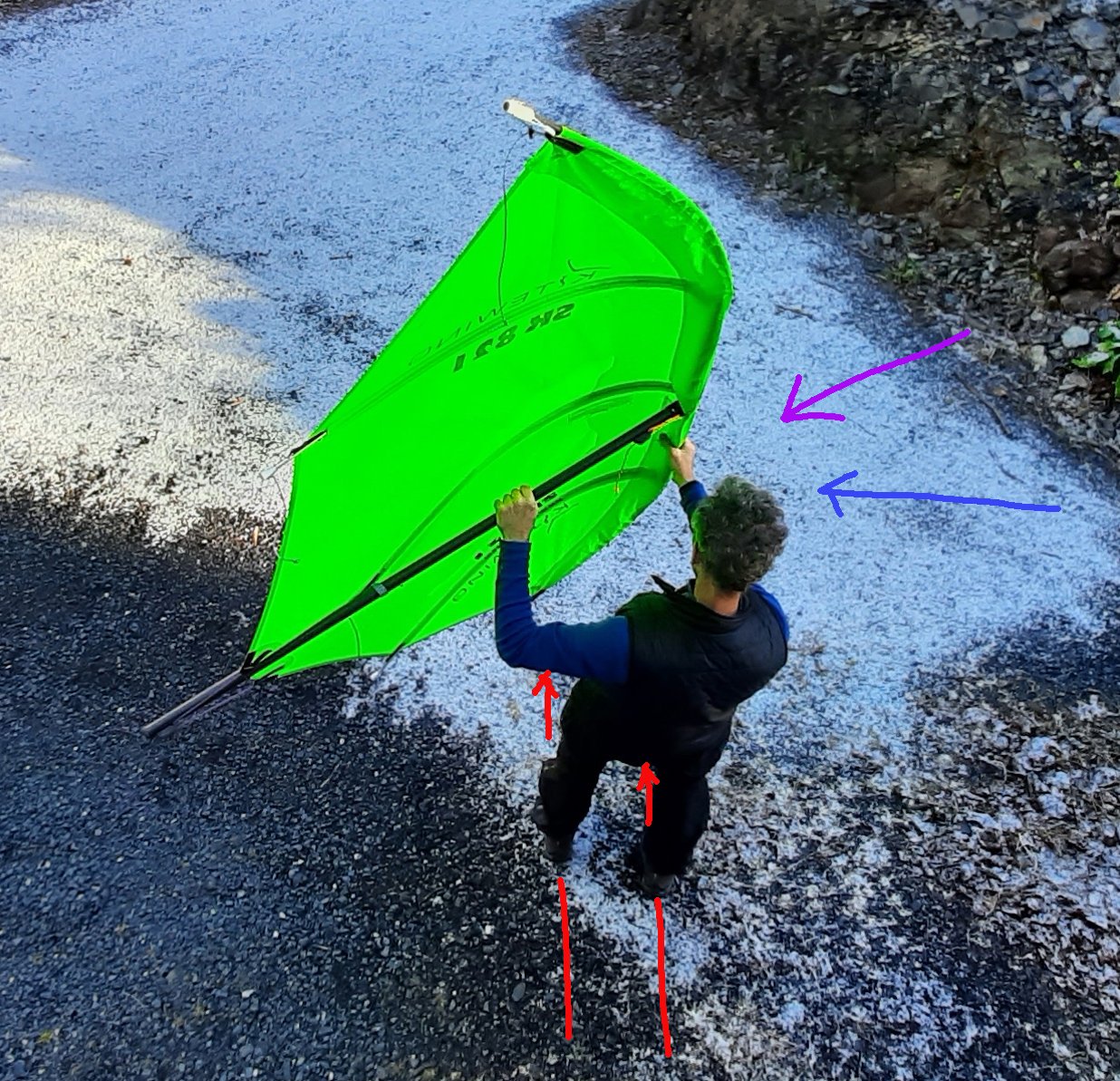By no means gospel: opinion
Catch as catch can. The blog entries reflect time spent fooling with hand held wing sails. Folks familiar with Kitewing LLC will find much familiar.
The longer we spend with hand held wings the more we learn. Wing designs evolve. Typical progressions include from heavy to light weight, better geometry, easier to handle, more aero dynamic.
Sailing techniques are influenced by the gear.
Along the way there are notes and observations which may or may not be dated as time marches on.
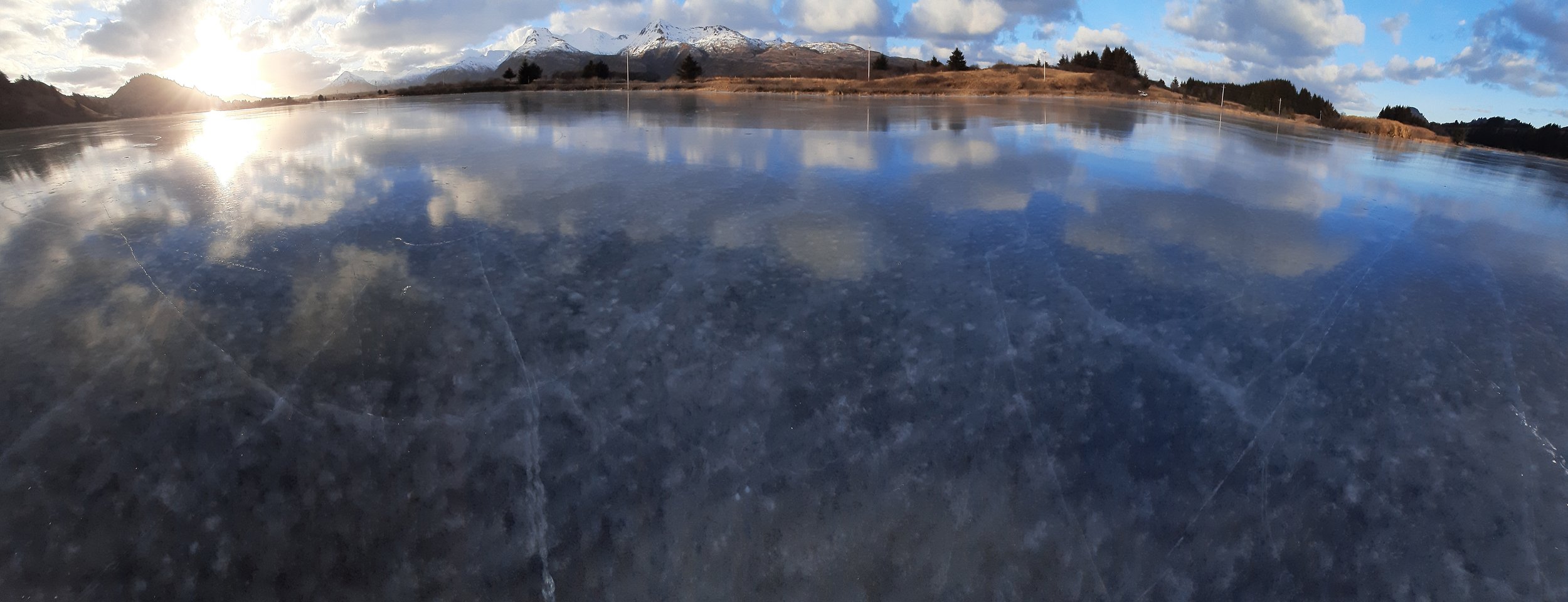
Wing Design at Kitewing LLC
Heavy to light weight.
Higher aspect ratios.
The search for better frame geometry.
How building ideas changes process as practice makes perfect.
What we think we know.
Kitewing 4.0, Lake Lee, Kodiak, AK DEC20
Frames
Kitewing LLC has moved away from heavy aluminum tubes. Aluminum tubes are relatively soft compared to newer carbon tubes.
Saving weight is crucial to wing performance at slow speeds. The slower it flies, the less wind it needs to fly, the easier it is to fly.
The latest Kitewing frame system is very light weight compared to older traditional frames with cross tubes. Eliminating the cross tube saved weight. Eliminating the nose joint saved complexity as well as weight.
A single boom saves complexity and weight. Y tubes and curved boom add about a pound as well as stiffen the rig. The Kitewing frame system can be adjusted for light to moderate wind without Y tubes, or add the Y tubes for easier handling and stiffer frame in high winds.
Frame geometry has evolved to produce a more adjustable frame, a stable wing designed to be easier to fly
Sails
Mylar sails are heavy. Spectra, Dyneema, or high molecular weight polyethylene has changed the game. HMWPE is light weight and strong as well as very durable. Dyneema, Cuben Fiber, Aluula, spectra, are all based on HMWPE fibers.
Sails are much lighter than they used to be. Sail shapes or wing shapes have trended to higher aspect ratios which are more efficient.
Kitewing branded Dyneema sails built at Ezzy Sails in Sri Lanka are very nice. Compared to older Kitewing monofilm or Dacron sails, the average weight saved by Dyneema fabric is about 2.5 ounces per sail makers yard of fabric. As an example: the 3 sq M Skimbat built from Dyneema saves almost 3/4 pound or close to 20% of the Dacron rig.
The stability of Dyneema fabric relative to its weight is unparalleled.
Sail designs do not include any concessions to appearance since extra seams or additional fabric add weight and complexity. Changes to sails reflect a commitment to improve rigging, to save weight and complexity of production.
Rigging
Rigging has evolved with the wings. New wings are more adjustable. RBS fiberglass battens allow an infinite range of camber tune between the camber inducer and tack tensioner.
It is common to see 4:1 purchase at tip tensioners. 2:1 purchase at batten tensioners. Dyneema sails tensioned against stiff carbon frames make the latest rigs less prone to give up shape as loads increase.
Human fingers are quite sensitive, attached to an arm, the sailor of any hand held wing is a living sensor to rival the most expensive complicated array of inert mechanicals designed to control a flying wing. You can feel the apparent wind on your face. If it feels good in your hands, you have it tuned correctly. Folks who take the time to learn the nuances of hand held wing tune are going to sail more efficiently. It pays to experiment.
Kitewing LLC Design
Kitewing LLC bought the brand from Kitewing OY.
At Kitewing LLC we respect the older designs but we have not remained mired in an evolution of product development clinging to dated design or sailing style.
It is inevitable. Understanding modern materials is crucial to affect progress. Carbon frames are an obvious example. The same for Dyneema sails.
We sail every season testing new designs and ideas. We sell what we sail. In Alaska we are on the ice from November to April.
Our product at Kitewing LLC reflects a commitment to customers. Dedication to customer support is important. We do not try to sell our customers hyperbole. Experience counts.
Lately we have discovered how much fun it is to go SUP sailing, potentially foil riding on soft water thereby extending our hand held wing time to a year round season.
My designs are influenced by my sailing experience. I am older now, less inclined to jump or fly my wing off the surface. I want to go sailing. I do not want to wait for enough wind. I emphasize light weight. I want to use my rig with cross country ski gear. I want to go touring. I want to sail and have fun on a small pond. I want to launch a board and ride.
Traditional Kitewing OY frames were built to take flying loads with higher safety margins. Kitewing OY marketing emphasized catching air or flying the wing off the surface. We have eliminated the cross tube and the plastic nose joint, thereby saving weight. Rigs are designed to switch from straight to curved with Y tubes booms without de rigging the sail. Switching booms makes the rig versatile, a light weight rig for light air, a heavier stiffer rig for heavy air. The latest Kitewing LLC frame system with Y tubes and curved boom allows for a stiff frame which can be used with a harness but it is not designed to be flown off the surface.
Kitewing LLC is a team. We are unable to produce anything without each other. There are folks who are not directly related to Kitewing LLC who play important roles. Hats off to Scott, Brooks, Erin, Stacey, Eric, Martin and Steve who all contribute in one way or another.
Latest Trends
The V tube. We designed a V tube which allows us to eliminate the nose joint. Our V tube can be oriented within the goose neck bracket to change dihedral as well as sweep. the ability to experiment with changes allows us to be more aware of what changing dihedral and sweep does to wing handling.
Less is more. We are exploring the potential of what we call the SUP sail. SUP sail is a simple rig with the same V tube and front tube extensions of the Kitewing frame system. Sails can be rigged with aluminum or RBS battens. The front tube can be stepped to the deck of an SUP or flown overhead. Versatile performance and simplicity define the SUP sail. Tensioners are easier to deal with: there is only one tip tensioner. The tip tension works with thicker chord. The SUP rig is unique.
All the best
Dicky 21DEC24
2.4 TW hard transformed snow, APR24, Kodiak, AK
Kitewing 5.0TW NOV24 Rosetead, Kodiak, AK
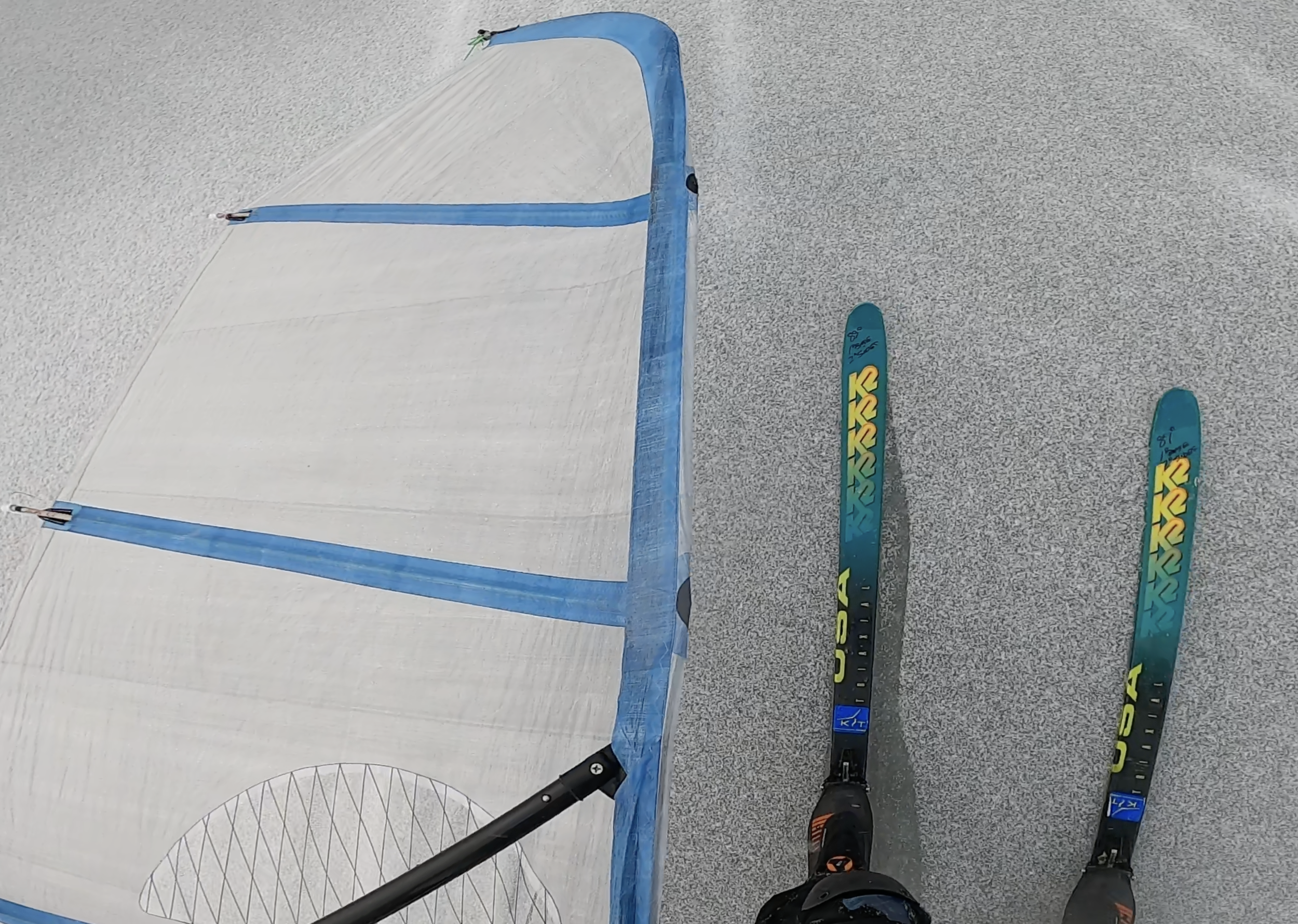
Which Wing? More detail 3JAN25
Bigger wings generate more lift with relatively high drag, weigh more.
Smaller wings weigh less, are easier to manipulate with less drag, are faster at top speeds.
Sticky surfaces require more lift.
Fast surfaces require less lift.
The slower it flies its own weight, the easier it is to catch a ride.
Light weight rigs do not require the same full shape as a heavier rig the same size to fly at slow speed. Ergo the light weight flat rig is going to perform within a much wider range of wind because at high speed there will be less induced drag. The flat rig will not buffet or roar when a full rig does.
Top speeds are important to racing sailors. However racing is not just about top speed. Racing is about speed relative to the other racers. Acceleration is important. Distance equals rate multiplied by time. At top speeds the relative difference in speed may not be enough to justify design concessions. A flat wing designed to go fast may not have the lift to fly at slower speeds relative to a full wing which can accelerate or sail faster relative to the flat wing at slower speeds maneuvering on a race course. Full rigs can bear further away down wind.
As far as I know the Kitewing 3.0 Sport remains the fastest hand held rig documented on the planet. Erik Karelfelt 103 kph or 64 mph, Kitewing 3.0 Sport
IMO the fastest speeds we achieve with the hand held wing are not as important as the ability to fly at a walking pace. Light weight rigs which can fly their own weight at a very slow pace are much easier to deal with when the wind dies. Skaters can push a wing along with no effort, power skate, or skate home or continue touring without taking the rig apart.
Stiff rigs maintain wing geometry or stability of shape better than soft rigs. Stable rigs are easier to sail.
Softer rigs do not maintain wing stability which translates to handling issues. However, any hand held wing can be flown over head weather cocked to avoid blustery puff or to survive too much wind. At some point the wind speed might be so high that the wing is easiest to control held by the nose at waist hight with two hands.
It used to be that we advised folks to sail the biggest wing they could handle. Larger rigs flew better at slower speeds, pulled harder, provided the best all around performance. Back in the day we spent a lot of time waiting for more wind. The vintage rigs are heavy, they require more wind to fly.
Today we advise folks to work on technique, be more aware of conditions, sail with the smallest rig which gets the job done. Smaller rigs are easier to deal with. This latest trend may be influenced by lighter weight more efficient smaller rigs which perform within a wider range of conditions. Larger rigs weigh enough to be too much when the wind dies.
If you are an ice skater looking for the premium skate sail with emphasis on light air, the Skimbat skate sail is for you.
Sailing on snow is slower, requires a bit more wing, or wind. Waiting for a bit more wind costs nothing but time. If you require big boost, go big. I prefer the Kitewing 5.0 TW in light air on snow. The 5.0 is light weight enough to be able to power skate on cross country skis.
There are inflatables out there with sail areas over 8 up to 9 sq M. Inflatable rigs are soft, produce a huge parasitic as well as induced drag signature, wing weights average about 1 lb per square M of wing area. Based on my recent experience on fast ice in light air, the inflatable did not fly its own weight at the same slow speeds as more efficient hard rigs with less than half of the inflated wing area.
On snow it is important to be aware of conditions. Do not get caught miles from the car with too much rig when the wind dies. Ability to roll and stow to a pack might be important. The inflatable packs to a reasonable size but it is not as easy to strap to a pack as a Kitewing skate sail which is designed to be rolled and stowed.
The Kitewing 5.0 TW is designed for slow sticky surfaces, sailing on skis. KW 5.0 TW rolls and stows to a pack.
SK8 is too heavy for premium light air skate sailing. Kitewing does not plan to build any more SK8 rigs since the SK821 is a more efficient rig.
SK821 is a more stable rig designed for higher wind speeds. SK821 was designed to be an upgrade from the SK8. SK821 uses the same frame as the venerable SK8. The sail is a bit larger with three RBS glass battens.
Kitewing 2.4 TW is the result of design aimed at upgrading the SK821. KW 2.4 TW is a bit heavier, improved aspect ratio design which we believe is also the fastest design to date. The 2.4 works well enough on ice in light air, but it is not in the same slow speeds efficient arena as the Skimbat. Close but not quite. However, the KW 2.4 TW worked better than a 5.5 M inflatable in light air on fast ice.
KW 3.0 TW is a durable rig small enough to be easy on a windy day. Not as nice as the Skimbat in light air, the 3.0 is a tight rig which can be pushed hard in heavy air. Without Y tubes the 3.0 is a quick relatively light weight performer.
Kitewing 5.0 TW works best in less wind. However it can be handled in heavy air with Y tubes for sailing on skis. The 5.0 is not a speed wing. Longer wing spans generate higher parasitic drag than short wing spans. KW 5.0 TW is an expert rig.
All the rigs at Kitewing work on snow or ice. Bigger wings generate more power quicker once they start to fly, smaller rigs are easier to learn on. Maybe waiting for wind is a cost effective compromise. Too much rig can be a hand full.
While any hand held wing can be handled in heavy air, the bigger the wing is, at some point the big rigs will require an expert wing handler. When the wings get over powered they are harder to manipulate.
Kitewing 6.0 Pro designed to fly early. This rig is vintage now.
Kitewing 5.5 Dacron, lighter than monofilm, full batten set, designed for more lift
More 6.0 Pro at sunset.
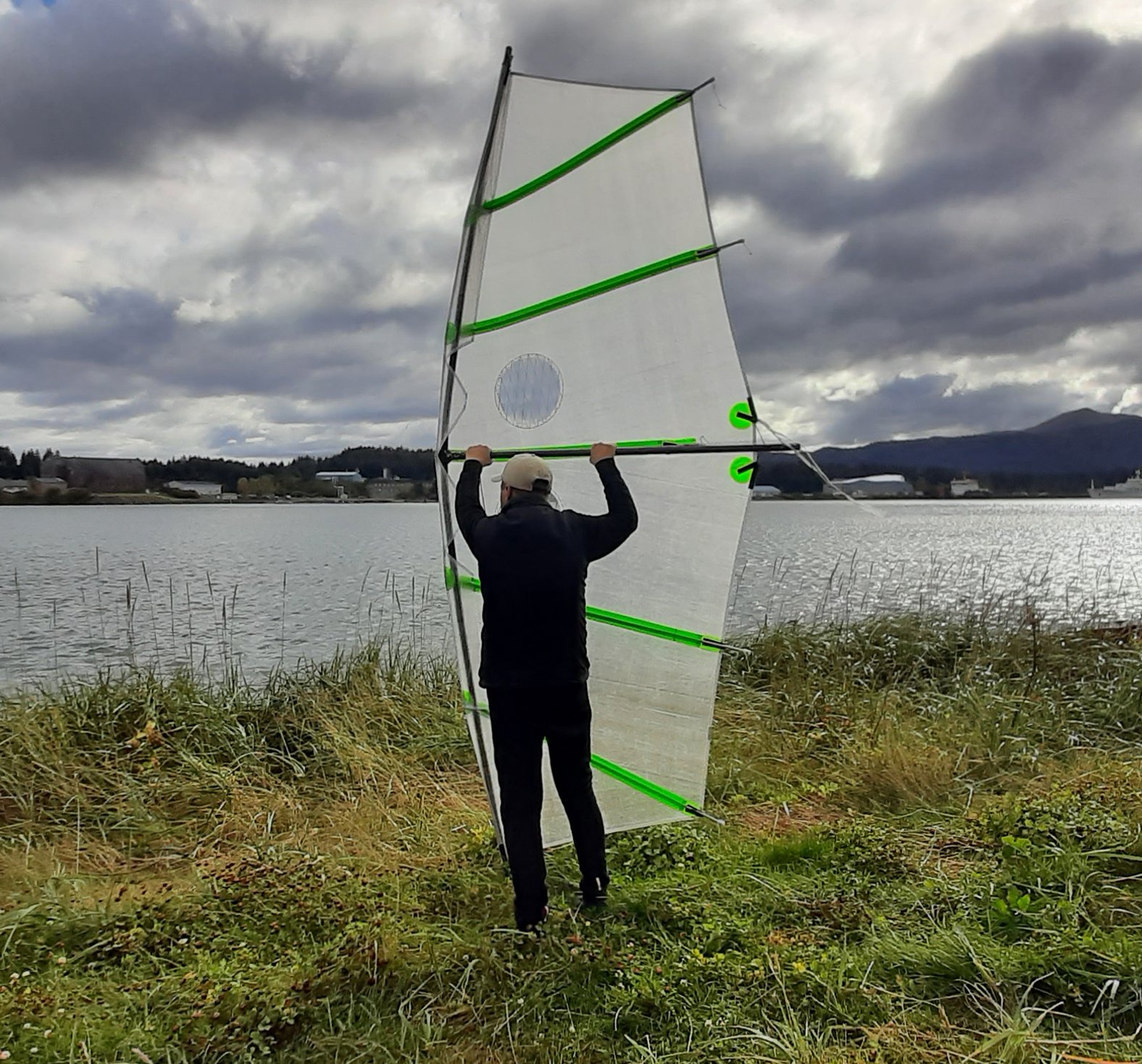
SUP sails
The first Skimbat built from Tyvek with straight aluminum spars. Circa March 2020. Testing on skis at Salonie Creek.
13DEC24 SUP Rig Genesis
Now comes the SUP sail.
Years back the initial design of the Skimbat skate sail relied on a straight front tube. Initial testing on snow went well enough. We took the rig to the water to see about SUP sailing. The best part of our water born test was to be able to deck step the front tube to manipulate the rig as if it were a wind surfer.
Without meaningful means to affect lateral resistance in the water, we were missing a centerboard, SUP testing died on the vine.
It was suggested to try an adhesive backed centerboard. We grabbed the old Skimbat proto type from the basement.
Long story short: to deck step your wing is an evolution of technique. Sailing a wind surfer is not so novel. SUP sailing is easier than riding foils. In fact SUP sailing is a great way to transition to riding a foil. Ergo our own efforts lately are all about the super cool SUP rig.
SUP rig simplicity, less parts, easy tensioner, uses durable and less expensive RBS glass battens, ability to deck step or fly make the design intriguing.
On a board, the SUP rig is more versatile than a pure wing because the SUP rig is designed to be deck stepped. Deck stepped wing sail allows us to take better advantage of lateral resistance. A wing requires to fly its own weight and then generate enough lift to carry a passenger to drag baggage around. A deck stepped rig does not have to support itself.
On the water from the deck of an SUP in light to moderate air it is easy to feel the difference in power generated, or force to the board, speed through the water, between the same rig flown as a wing or deck stepped. Deck stepped rigs pull harder than the same rig flown as a wing.
On the ice the SUP rig works supremely well. We suspect this is because the square wing tip may be more efficient than the winglet induced by a tip wand. Our 3.4 M SUP rig performs equally with the Skimbat skate sail which is the most efficient light air wing sail or skate sail we know. Both rigs are close to the same sail area. The SUP is heavy by about a pound.
SUP rig is very simple to set up or rig. Best and most efficient yet.
It is easier to teach beginners to sail while they can drop the front tube to the ground to land sail. The same works on the ice. SUP front tube can be dropped to the ice; the end caps are tough enough to ride a smooth ice surface.
Technique
17DEC24
Sailing technique has evolved along with hand held wing design. As wings are much lighter with better shape they are easier to manipulate. Easy to manipulate wings allow quicker maneuvers.
It has always been true of hand held wings, spin the wing like a frizbee to make it change direction. Fly the wing as if it is an airplane.
However the hand held wing is not limited by a fuselage and a pilot who stay oriented with the front to back axis of the wing.
Hand held wings can be manipulated and controlled beyond the capability of an air craft.
For instance: the hand held wing sailor can spin the wing to get it going even while the sailor is moving in a different direction. The best example might be the down wind gybe. It depends on over the ground speed, whether or not speed over ground is more or less than wind speed. Gybe going slower than wind speed and the wing can act like a conventional sail on a boat. Going faster than wind speed, the wing can be directed at flow generated by over ground speeds regardless of true wind direction.
Its possible to run over your wing if you are going faster than the wind is blowing.
Its possible to direct your wing to take advantage of the wind vector while you are going in a different direction in the middle of a gybe or tack.
Airplane pilots worry about stalling. Hand held wing sailors learn to avoid stalls, however, stalling the hand held wing does not risk falling out of the air.
The quicker you can direct your wing to find available flow, the quicker it will start to pull.
Beginners need to be able to find the true wind direction. Experts need appreciate that there is always something new to learn.
Stiff light weight rigs are easier to pump. The latest SUP sail can be pumped to generate decent speeds on fast ice. Older heavy traditional rigs can be pumped but it is hard to manipulate a heavy rig fast enough to generate much flow.
Easier to manipulate is easier to sail. Easier to sail and you will experiment with technique.
Hold your rig over head. Stand facing the wind. Turn 90 degrees to the wind direction, so the wind is blowing on one side of your face. Grab the leading edge of your rig or the Y tube with the hand closest to the wind, the down wind hand is on the boom.
Red arrows show intended direction of trravel. Blue arrow represents true wind direction. Purple arrow represents combined apparent wind.
Rig is SK 821 with RBS glass battens tuned full to show obvious camber.
Pix is example of static sailing without skates or skis. Practice staic sailing.
Batten Tensioners
Batten tensionbers are counter intuitive. Pull on the inside chord. The tensioner tube acts as a cam to jam the chord against the batten. DEC24
Kitewing Frame System: Booms DEC24
The rig does not need the boom to be installed to support the sail. Booms can be swapped from straight boom without Y tubes to a curved boom with Y tubes. Booms pin to front tube at the nose or tack while snap pins secure the Y tubes.
Sailing without Y tubes is a bit different for those of us who are used to traditional Kitewing hard frames.
Spin the wing to control the wing. The leading edge which is moving ahead will rise, while the opposite edge which is going backwards will dip. Traditional rig sailors all recall the counter intuitive, "Push the boom away to avoid driving the leeward wing tip in to the surface."
Y tubes allow for more forgiving control of the wing. The Y tube is connected to the front tube as well as the boom which permits a more secure one handed grip. With a single straight boom its like riding a bike, the sailor learns where to grip the boom for single handed sailing.
Booms
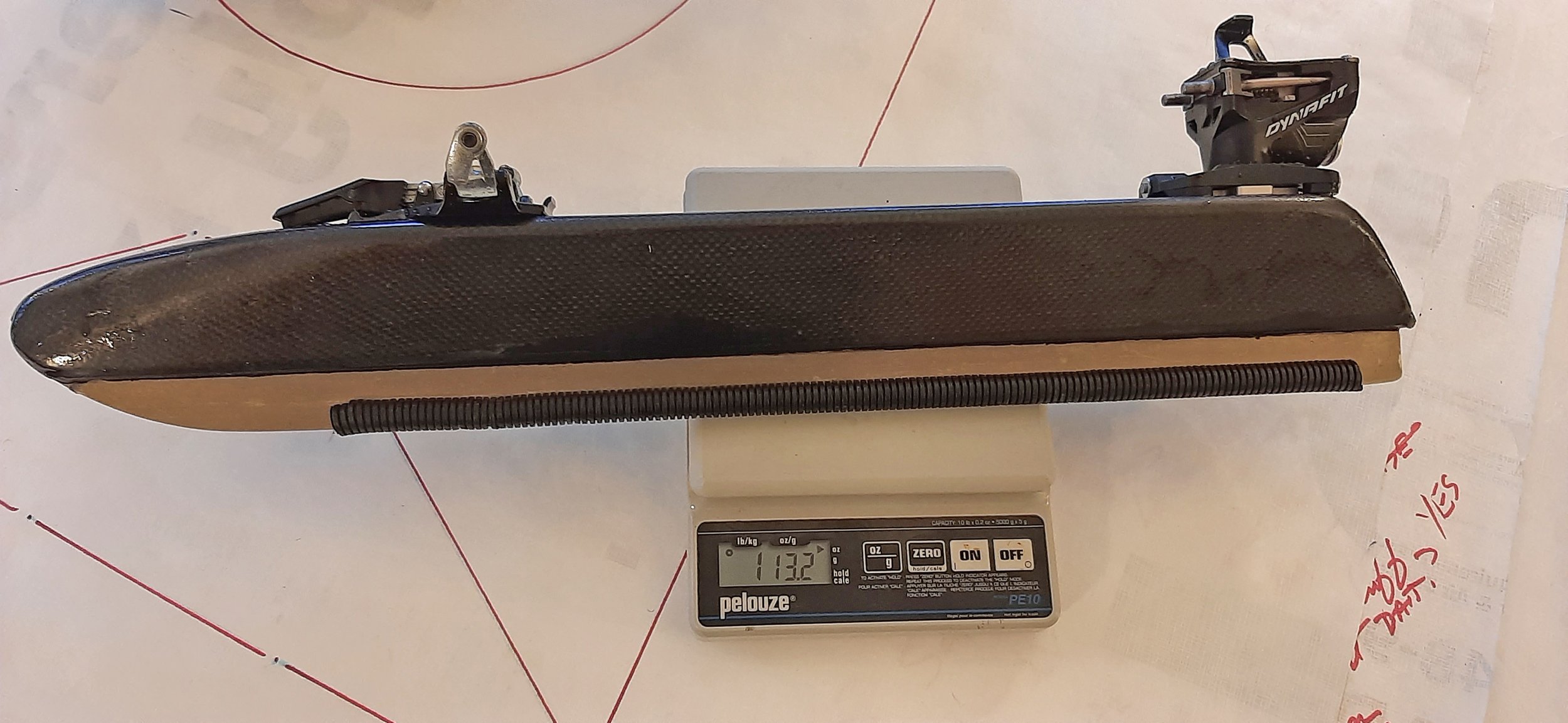
Carbon fiber skate bodies
25JAN25
Carbon fiber skate bodies are stiff and light weight. Mine float the blades as well as the tech bindings I use. Safety is an issue. Heavy skates can drag you down if you go through the ice.
So far building the skate body is a simple job. Blades are Lundhawg 55cm SS which have come out of their original extrusion. We think longer blades are nicer for hand held wing sailing. Stay tuned.
Blade profile as well as blade material are crucial to skate performance. So far the gold standard is defined by the Ermine Williwaw. Lundhawg blades are soft. Ermine Willies are just right, not so hard to sharpen but they hold an edge on clean ice.
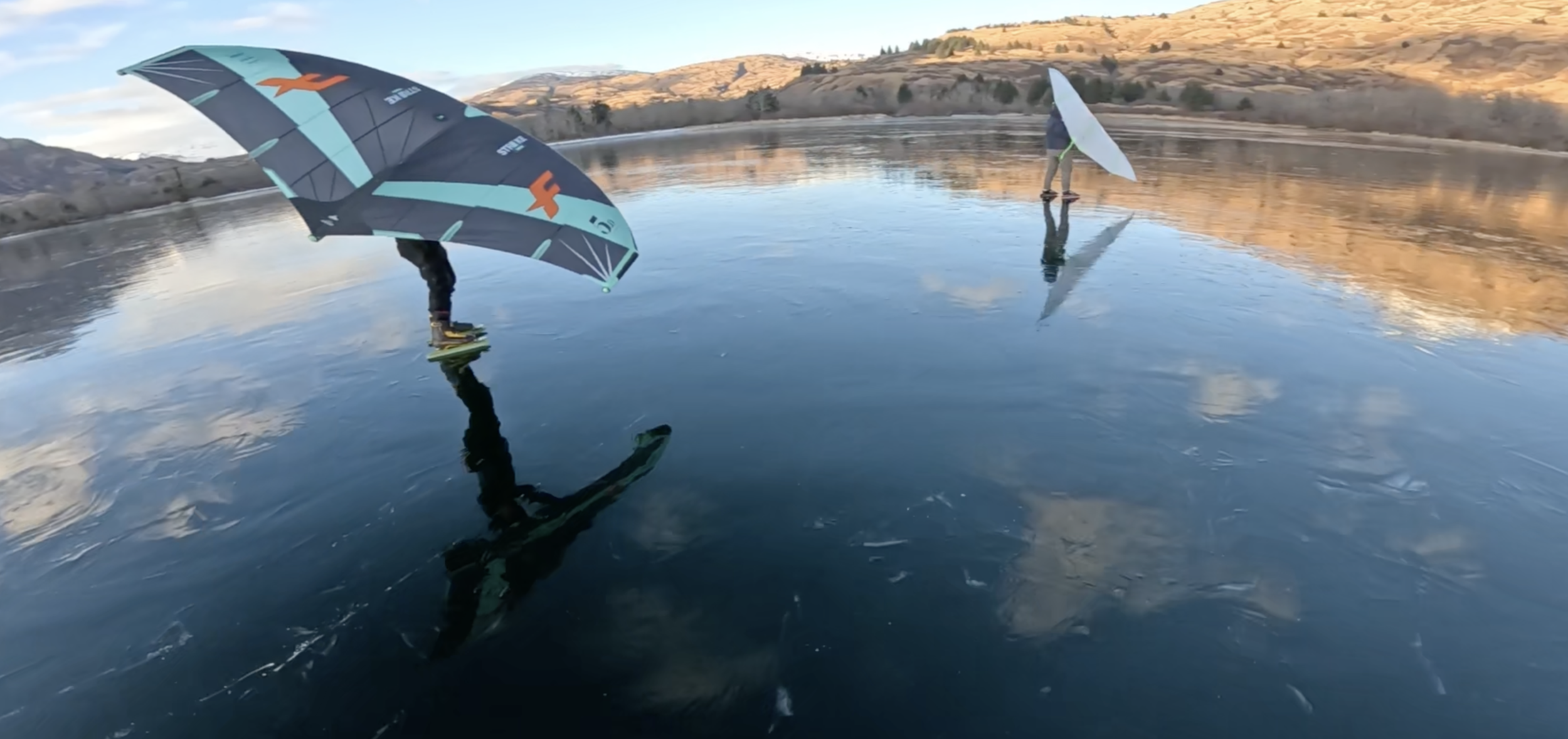
Inflato vss the hard wing
I have had some serious time to compare the inflato to the hard wing. Trials have included all manner of wind speeds from ice to water surfaces.
The inflated wing does not compare favorably. Not enough said.
There is no way speeds will ever be very high with such an extreme inflated drag bucket. Eliminating drag is crucial to high speeds. Even our own 2.4 TW is noticeably slower when it is sailed with Y tubes.
We played the hanger queen game on nice ice in light air, the kind of breeze you can barely feel on your cheek. Inflato never lasted more than five minutes with any test sailor. In my opinion the inflated wing lacks geometry which could allow it to be power skate sailed or scooter sailed, the sort of sailing which relies on a skater to generate flow.
The latest 3.4SUP sail can be flown off one hand very aggressively. The rig can be pumped and power skated with ease.
Our F1 strike three 5.0 required too much speed to fly. Handles are located in awkward places. Our inflatable rig cannot be controlled as easily as a comparable wing with a hard frame.
As light breezes pick up, the inflated rig works well enough. Top speeds are low compared to hard rigs like our own SUP rig or the 5.0 TW. If you want to go really fast the 2.4 TW is the way to go. Get rid of the Y tubes for a clean rig. Screamer scary speeds with the 2.4.
On the water, from the deck of an SUP, the inflated rig handles awkwardly. It does not flip or rotate or come out of or off the water any better than a hard rig. When the upside down inflato catches a swimming pool full of water it can be tough to deal with. The only favorable quality would be noting that the inflated spar is a nice crutch for geriatric shaky guys like me. Otherwise the hard rig is easier to deal with in all other respects. The wing tips of the 5.0 inflato drag harder on the water than the tips of a hard wing.
Today in steady 10mph or so breeze on the nicest ice, the 5.0 inflato is awkward to manipulate. I know what to do to make it tack or gybe but the rig is to much drag to spin with the same precise handling as a good hard wing. Handles of the inflato are optimized for two hand manipulation. The inflato was slow. Noticeably slow. Smaller skate sails, the 2.4TW and 3.4 SUP rigs can combine apparent to pull harder and go faster. Beginners did not like the inflatable compared to the 2.4 TW or the SUP. The inflato remained tethered at the pits.
The first step with every beginner is to get them to face the breeze, hold the wing by the nose. Let the wing be a weathervane. Watch folks get a handle on allowing a wing to find neutral. The inflated wing has too much affective sweep. Inflato would sashay around or yaw back and forth compared to a much more stable SUP rig. SUP rig is very stable facing the breeze.
29NOV24










